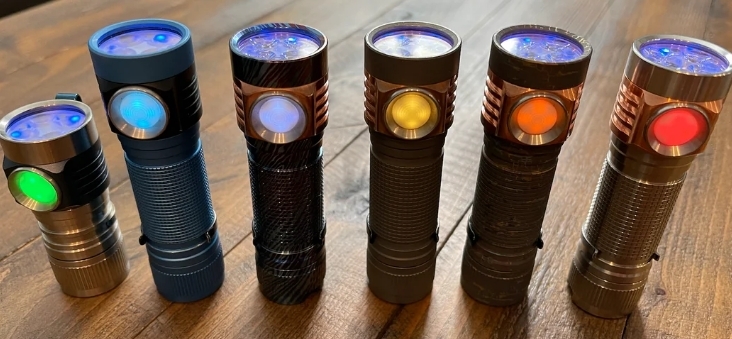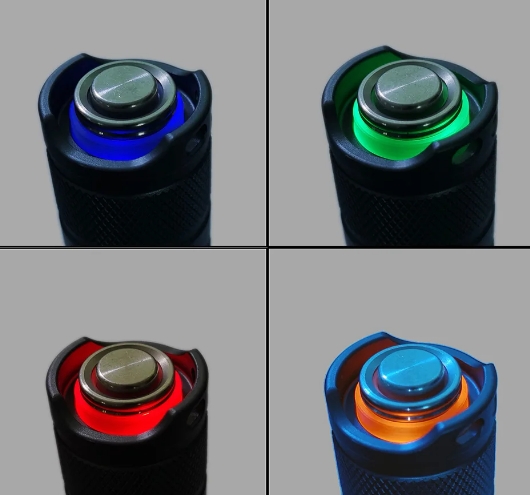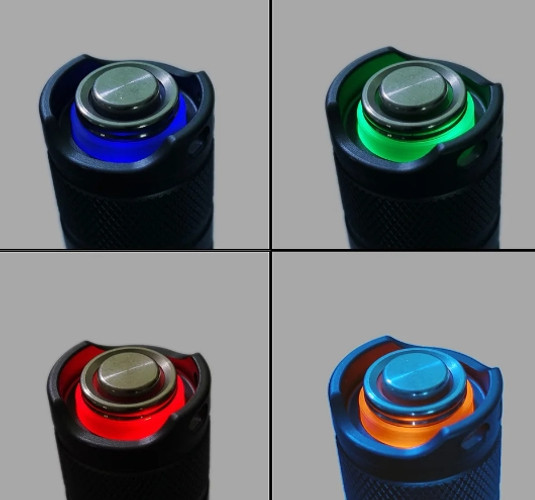How to Choose the Best Button Flashlight for Your Needs
Posted by Raymond on 17th Feb 2025
When it comes to choosing the right button flashlight, whether for everyday carry (EDC), outdoor adventures, or specialized tasks like 365nm UV flashlight applications, the options can be overwhelming. From button type to size and brightness, it’s important to know what features to prioritize based on your needs. In this article, we’ll guide you through the process of selecting the best button flashlight tailored to your requirements, offering comparisons, key features to look for, and expert tips.
1. Understanding Button Flashlights: What Makes Them Different?

A button flashlight is a flashlight that uses a button for its on/off switch, usually located on the tail or side of the flashlight. The button mechanism can vary, with options like tail click buttons, side push buttons, and soft-touch buttons. The choice of button type influences how easily you can operate the flashlight in different situations, such as while wearing gloves or in one-hand operation scenarios.
Key Benefits of Button Flashlights:
- Ease of Use: Buttons allow for simple, tactile control.
- Reliability: They are less prone to failure compared to twist-on flashlights.
- Variety of Designs: Available in various shapes and sizes for different needs.
2. Key Factors to Consider When Choosing a Button Flashlight
When selecting the best button flashlight, consider these important features:
a. Type of Button: Tail vs. Side Buttons
The type of button affects how you interact with the flashlight. A tail button is ideal for tactical use because it allows for easy on/off activation, especially when the flashlight is in your pocket or bag. Side buttons, on the other hand, are more common on smaller, compact flashlights and offer a more ergonomic grip.
| Button Type | Best For | Pros | Cons |
|---|---|---|---|
| Tail Button | Tactical and EDC use | Easy access, even with gloves | May be harder to operate with one hand |
| Side Button | Small, everyday carry flashlights | More ergonomic, compact design | May require more effort to locate in the dark |
| Soft Touch Button | For sensitive, low-profile flashlights | Provides smoother control and feedback | May wear out quicker if used frequently |
b. Brightness and Beam Type
The brightness of a flashlight is typically measured in lumens. The higher the lumens, the brighter the beam. However, the beam type is just as important as brightness, especially for 365nm UV flashlights, which require specific wavelengths for certain applications like leak detection or forensic use.
| Flashlight Type | Brightness | Use Case |
|---|---|---|
| General LED Flashlight | 100-1000 lumens | Everyday carry, outdoor activities |
| 365nm UV Flashlight | Low lumens, high UV intensity | Leak detection, forensics, mineral fluorescence |
| High-Powered Tactical Flashlight | 1000-3000 lumens | Search and rescue, camping, tactical use |
c. Battery Life and Rechargeability
A long battery life is essential for any flashlight. If you’re choosing a 365nm UV flashlight for fieldwork, you’ll need one that offers a long runtime without frequent charging. Some flashlights come with rechargeable batteries, which are eco-friendly and cost-effective in the long term.
| Battery Type | Run Time | Charging Type | Best For |
|---|---|---|---|
| Non-Rechargeable (AAA/AA) | 1-3 hours at full brightness | Standard battery replacement | Budget-friendly options, emergency kits |
| Rechargeable (Lithium-ion) | 4-12 hours at various brightness levels | USB charging or dock station | High-end models, frequent users, eco-friendly |
| AA/AAA + Rechargeable Combo | 2-6 hours (depending on usage) | Rechargeable AA or AAA batteries | Versatile, moderate use flashlights |
3. Special Features to Look For in a Button Flashlight

Depending on your specific needs, you may want a button flashlight with additional features:
a. Waterproof and Impact Resistance
A durable flashlight that can withstand tough environments is essential for outdoor enthusiasts or professionals in rugged fields. Look for a flashlight with an IPX rating (e.g., IPX7, which is waterproof up to 1 meter) and impact-resistant design.
b. Adjustable Focus and Zoom
For versatile use, an adjustable focus can allow you to switch between a wide floodlight for large areas and a narrow spotlight for long-distance visibility. This is especially useful in tactical or search and rescue situations.
c. UV Functionality (365nm UV Flashlight)
For professionals in fields such as forensics or pest control, a 365nm UV flashlight is a game-changer. UV flashlights can reveal hidden stains, leaks, and counterfeit materials that are invisible to the naked eye.
| Feature | Ideal For | Examples |
|---|---|---|
| Waterproof | Outdoor activities, underwater use | IPX7-rated, waterproof flashlight |
| Adjustable Focus | Tactical use, spotlight and floodlight needs | Tactical zoom flashlights |
| UV Functionality (365nm) | Leak detection, forensics, art restoration | 365nm UV flashlights for professional use |
4. How to Choose the Best Button Flashlight for Your Specific Needs
To help narrow down your options, here’s a quick guide based on common use cases:
| Use Case | Recommended Flashlight Type | Key Features to Look For |
|---|---|---|
| Everyday Carry (EDC) | Compact button flashlight (tail or side button) | Small size, ergonomic design, medium brightness, long battery life |
| Outdoor Adventures | High-powered tactical flashlight | High lumens, waterproof, adjustable focus |
| Forensics and Inspection | 365nm UV flashlight | UV capability, rechargeable battery, portable design |
| Emergency/Survival | Multi-functional button flashlight | Long battery life, impact resistance, high brightness |
| Pest Control | 365nm UV flashlight for UV-sensitive pests | UV-specific beam, compact size, long runtime |
5. Conclusion: Making the Right Choice
Choosing the best button flashlight depends on your unique needs. Whether you’re looking for a 365nm UV flashlight for professional use or a reliable flashlight for daily tasks, focus on the features that matter most—brightness, battery life, durability, and ease of use. Keep in mind your environment and specific tasks, and select the flashlight that best matches those requirements.

